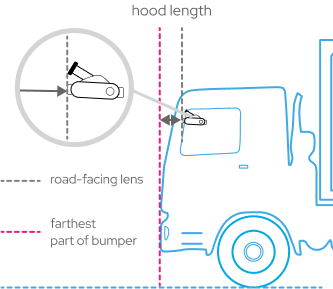How do I take measurements for DV6 ADAS calibration?
How to take the required vehicle measurements for DV6 ADAS
In order to take advantage of the powerful ADAS functionality of your DV6 camera, you must first enter some vehicle measurements for the camera to properly calibrate.
Depending on the type of vehicle the camera is installed into, the site of the measurements may differ slightly. To help with this, we've separated the vehicle types into the following categories:
- Car / Sedan

- Pickup Truck / Van

- Step Van

- Flat-nose / Cab-over

- Bus / Truck

Measurements
To take the following measurements, all you will need is a measuring tape. Ensure the vehicle is on flat and level ground for the best measurements.

Find the center line
First step is to find the center line of the vehicle and make a reference mark so you can easily measure from this center line.

Vehicle Hood Length
This measurement is taken in a straight line from the channel 1 camera (road facing) lens to the farthest part of the bumper. For example, if your vehicle has a snowplow attachment on the front, you will measure to the front of the snowplow since it is the farthest part of the bumper.
Car / Sedan

Pickup Truck / Van

Step Van

Flat-nose / Cab-over


Bus / Truck

Vehicle Width
This measurement is taken on the body of the vehicle from left-side to right-side for the width of the vehicle.
Take care NOT to include side-view mirrors into this measurement.
Car / Sedan


Pickup Truck / Van

Step Van


Flat-nose / Cab-over


Bus / Truck


Camera Height
This measurement is taken in a straight line from the channel 1 camera (road facing) lens to the ground the vehicle rests on.
This is NOT the measurement to the floorboard but the actual ground the vehicle is sitting on.
It is recommended to record the distance from the ground to the bottom of the vehicle, then record the distance from the camera to the floorboard and add those two measurements for the total camera height.
Car / Sedan


Pickup Truck / Van


Step Van


Flat-nose / Cab-over


Bus / Truck


Camera Offset
This measurement is taken from the channel 1 camera (road facing) lens to the center line of the vehicle. To denote whether the offset is to the passenger side of the vehicle, make the measurement negative. Conversely, if the offset is to the driver side of the vehicle, make the measurement positive. If the camera is centered on the vehicle center line, then this measurement can be left as 0.
If your vehicle has a split windshield, consider the center dividing pillar between the windshields as the center line and measure from there as you would normally.
Car / Sedan


Pickup Truck / Van

Step Van


Flat-nose / Cab-over


Bus / Truck
